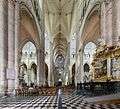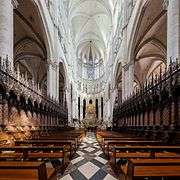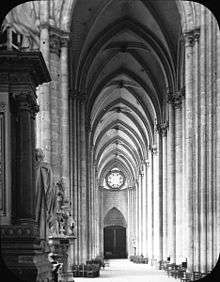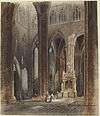Amiens Cathedral
The Cathedral Basilica of Our Lady of Amiens (French: Basilique Cathédrale Notre-Dame d'Amiens), or simply Amiens Cathedral, is a Roman Catholic church. The cathedral is the seat of the Bishop of Amiens. It is situated on a slight ridge overlooking the River Somme in Amiens, the administrative capital of the Picardy region of France, some 120 kilometres (75 miles) north of Paris.
| Amiens Cathedral | |
|---|---|
| Cathedral of Our Lady of Amiens | |
French: Notre-Dame d'Amiens | |
Amiens Cathedral | |
 Amiens Cathedral | |
| 49°53′42″N 2°18′08″E | |
| Location | Amiens |
| Country | |
| Denomination | Roman Catholic Church |
| Website | www |
| History | |
| Status | Cathedral |
| Relics held | Alleged head of John the Baptist |
| Architecture | |
| Functional status | Active |
| Architect(s) | Robert of Luzarches Thomas and Regnault de Cormont[1] |
| Style | Gothic |
| Years built | 13th century |
| Specifications | |
| Length | 145 m (476 ft) |
| Width | 70 m (230 ft) |
| Nave width | 14.60 m (47.9 ft)[2] |
| Height | 42.30 m (138.8 ft) |
| Other dimensions | Façade: NW |
| Floor area | 7,700 square meters |
| Number of spires | 1 |
| Spire height | 112.70 m (369.8 ft)[2] |
| Administration | |
| Diocese | Amiens |
| Province | Reims |
| Clergy | |
| Bishop(s) | Bishop Jean-Luc Bouilleret[3] |
| Official name | Amiens Cathedral |
| Type | Cultural |
| Criteria | i, ii |
| Designated | 1981[4] |
| Reference no. | 162 |
| State Party | France |
| Region | Europe and North America |
| Session | 5th |
| Official name | Cathédrale Notre-Dame |
| Designated | 1862 |
| Reference no. | PA00116046[1] |
| Denomination | Église |
Medieval cathedral builders were trying to maximize the internal dimensions in order to reach for the heavens and bring in more light. In that regard, the Amiens cathedral is the tallest complete cathedral in France, its stone-vaulted nave reaching an internal height of 42.30 metres (138.8 ft) (surpassed only by the incomplete Beauvais Cathedral). It also has the greatest interior volume of any French cathedral, estimated at 200,000 cubic metres (260,000 cu yd). The cathedral was built between 1220 and c. 1270 and has been listed as a UNESCO World Heritage Site since 1981.[5] Although it has lost most of its original stained glass, Amiens Cathedral is renowned for the quality and quantity of early 13th-century Gothic sculpture in the main west façade and the south transept portal, and a large quantity of polychrome sculpture from later periods inside the building.
Construction

The lack of documentation concerning the construction of the Gothic cathedral may be in part the result of fires that destroyed the chapter archives in 1218 and again in 1258—a fire that damaged the cathedral itself. Bishop Evrard de Fouilly initiated work on the cathedral in 1220. Robert de Luzarches was the architect until 1228, and was followed by Thomas de Cormont until 1258. His son, Renaud de Cormont, acted as the architect until 1288. The chronicle of Corbie gives a completion date for the cathedral of 1266. Finishing works continued, however. Its floors are covered with a number of designs, such as the bent cross (to symbolize Jesus' triumph over death). The labyrinth was installed in 1288. The cathedral contains the alleged head of John the Baptist, a relic brought from Constantinople by Wallon de Sarton as he was returning from the Fourth Crusade.
The construction of the cathedral at this period can be seen as resulting from a coming together of necessity and opportunity. The destruction of earlier buildings by fire, and failed attempts at rebuilding forced the fairly rapid construction of a building that, consequently, has a good deal of artistic unity. The long and relatively peaceful reign of Louis IX of France brought prosperity to the region, based on thriving agriculture and a booming cloth trade, that made the investment possible. The great cathedrals of Reims and Chartres are roughly contemporary.
Structural defects
The original design of the flying buttresses around the choir had them placed too high to counteract the force of the ceiling arch pushing outwards resulting in excessive lateral forces being placed on the vertical columns. The structure was only saved when, centuries later, masons placed a second row of more robust flying buttresses that connected lower down on the outer wall. This fix failed to counteract similar issues with the lower wall which began to develop large cracks around the late Middle Ages. This was solved by another patch by the master mason Pierre Tarisel, that consisted of a wrought iron bar chain being installed around the mezzanine level to resist the forces pushing the stone columns outward. The chain was installed red hot to act as a cinch, tightening as it cooled.[6]
The exterior
The west front of the cathedral, built in a single campaign from 1220 to 1236, shows an unusual degree of artistic unity: its lower tier with three vast deep porches is capped with the gallery of twenty-two over lifesize kings, which stretches across the entire façade beneath the rose window. Above the rose window there is an open arcade, the galerie des sonneurs. Flanking the nave, the two towers were built without close regard to the former design, the south tower being finished in 1366, the north one, reaching higher, in 1406.
The western portals of the cathedral are famous for their elaborate sculpture, featuring a gallery of locally-important saints and large eschatological scenes. Statues of saints in the portal of the cathedral have been identified as including the locally venerated Saints Victoricus and Gentian, Saint Domitius, Saint Ulphia, and Saint Fermin.[7]
The spire over the central crossing was added between 1529 and 1533.[2] The surface area is 7,700 square meters — the largest in France.
The façade in colour
During the process of laser cleaning in the 1990s, it was discovered that the western façade of the cathedral was originally painted in multiple colours. A technique was perfected to determine the exact make-up of the colours as they were applied in the 13th century. Then, in conjunction with the laboratories of EDF and the expertise of the Society Skertzo, elaborate lighting techniques were developed to project these colours directly on the façade with precision, recreating the polychromatic appearance of the 13th century. When projected on the statues around the portals, the result is a stunning display that brings the figures to life. The projected colors are faint to photograph, but a good quality DSLR camera provides excellent results, as shown below.
The full effect of the colour may be best appreciated by direct viewing, with musical accompaniment, which can be done at the Son et lumière shows which are held on Summer evenings, during the Christmas Fair, and over the New Year.[8][9]
- Cathedral exterior gallery
 Transept and north stained glass
Transept and north stained glass Choir and its altar, under the East window
Choir and its altar, under the East window Gargoyle and sculptural details
Gargoyle and sculptural details View from the north, with flying buttresses and flèche (central spire).
View from the north, with flying buttresses and flèche (central spire).- Tympanum of central west portal: Christ in Majesty presiding over the Day of Judgement while being supported by an array of saints
- Illumination of the original colours of the façade
- Local saints including the decapitated martyrs, Victoricus and Gentian, at the western entrance
- The western entrance illuminated with the sculptural group on the left which includes the decapitated saints, Victoricus, Fuscian, and Gentian
- Relief at lower level of the western entrance with a hedgehog as alluded to in Zephaniah 2:13-2:14.
 Cathedral of Nôtre Dame, Amiens in 1852
Cathedral of Nôtre Dame, Amiens in 1852 Cathedral, Amiens. Facade, 1903.
Cathedral, Amiens. Facade, 1903. Cathedral, Amiens. The choir exterior, 1903.
Cathedral, Amiens. The choir exterior, 1903. Cathedral, Amiens. Lower part of façade to Gallery of Kings inclusive, 1903.
Cathedral, Amiens. Lower part of façade to Gallery of Kings inclusive, 1903. Cathedral, Amiens, west/south-west aerial view, 1878
Cathedral, Amiens, west/south-west aerial view, 1878 Cathedral, Amiens, central portal (West front), 1878
Cathedral, Amiens, central portal (West front), 1878 Cathedral, Amiens, choir looking west, 1878
Cathedral, Amiens, choir looking west, 1878 Cathedral, Amiens, north transept interior, 1878
Cathedral, Amiens, north transept interior, 1878
The interior
Amiens cathedral contains the largest medieval interior in Western Europe, supported by 126 pillars. Both the nave and the chancel are vast but extremely light, with considerable amounts of stained glass surviving, despite the depredations of war.

The ambulatory surrounding the choir is richly decorated with polychrome sculpture and flanked by numerous chapels. One of the most sumptuous is the Drapers' chapel. The cloth industry was the most dynamic component of the medieval economy, especially in northern France, and the cloth merchants were keen to display their wealth and civic pride. Another striking chapel is dedicated to St Thomas of Canterbury, a 13th-century dedication that complements the cathedral's own very full list of martyrs.
The interior contains works of art and decoration from every period since the building of the cathedral. There are notably baroque paintings of the 17th century, by artists such as Frans II Francken and Laurent de La Hyre.
- Cathedral interior gallery
 Nave of Notre-Dame d'Amiens looking toward the western façade
Nave of Notre-Dame d'Amiens looking toward the western façade South aisle looking westward
South aisle looking westward Close-up of a stained glass window
Close-up of a stained glass window Chapel of the Virgin Mary
Chapel of the Virgin Mary Nave of Notre-Dame d'Amiens
Nave of Notre-Dame d'Amiens Nave vaults of Notre-Dame d'Amiens
Nave vaults of Notre-Dame d'Amiens Chapel of Notre-Dame de Puy (1627-1628)
Chapel of Notre-Dame de Puy (1627-1628) Gisant of Evrard de Fouilloy, bishop of Amiens (1211-1222)
Gisant of Evrard de Fouilloy, bishop of Amiens (1211-1222)- Rose of the northern transept
 Gothic choir stalls (1508-1519)
Gothic choir stalls (1508-1519) Right side of nave from organ gallery. Plumb-line from stick from gallery right near transept. Showing vertical curves and widening, 1906.
Right side of nave from organ gallery. Plumb-line from stick from gallery right near transept. Showing vertical curves and widening, 1906. Nave from above altar, looking back toward organ gallery and entrance
Nave from above altar, looking back toward organ gallery and entrance Left (north) view of transept from Triforium, showing the outward lean of the wall and of the pier in the angle, 1903.
Left (north) view of transept from Triforium, showing the outward lean of the wall and of the pier in the angle, 1903.

 The famous Weeping Angel, a 17th-century sculpture on a tomb in the ambulatory, directly behind the high altar
The famous Weeping Angel, a 17th-century sculpture on a tomb in the ambulatory, directly behind the high altar David Roberts, Interior of Amiens Cathedral, ca. 1827, Princeton University Art Museum
David Roberts, Interior of Amiens Cathedral, ca. 1827, Princeton University Art Museum
John the Baptist's head
The initial impetus for the building of the cathedral came from the installation of the reputed head of John the Baptist on 17 December 1206. The head was part of the loot of the Fourth Crusade, which had been diverted from campaigning against the Turks to sacking of Constantinople, the great capital of the Byzantine Empire. A sumptuous reliquary was made to house the skull. Although it was later lost, a 19th-century replica still provides a focus for prayer and meditation in the North aisle.
Renaissance polychrome sculpture
Some of the most important works of art are sequences of polychrome sculpture, dating mainly from the late 15th and the 16th centuries. A large sequence in the North transept illustrates Jesus' Cleansing of the Temple, with imaginative tableaux of the Temple. Both sides of the ambulatory are lined with sequences illustrating the lives of the two saints whose cults brought large numbers of pilgrims to the cathedral: John the Baptist and St Firmin, the first bishop of Amiens. The artists took care to create a parallelism in the telling of the stories: both saints, decapitated for offending the rich and powerful, suffer neglect and loss, until a later generation discovers their relics and houses them fittingly.
The pulpit
The baroque pulpit, constructed of marble and gilded wood, dominates the nave of the cathedral. It is supported by three allegorical female figures, apparently representing Faith, Hope and Charity, the three Theological Virtues.
- Sculpture gallery
- John's impending birth as announced to his priestly father, Zachariah, who is struck dumb
- Visitation of the Virgin Mary to John's mother, St. Elizabeth, who feels John the Baptist stirring within her womb
- John being named by his father Zachariah who being struck dumb is forced to communicate in writing
- John the Baptist preaching repentance in the desert
- John baptising in the River Jordan
- John being asked if he is the expected Messiah
- John proclaiming Jesus as the Lamb of God
- John being arrested, brought before Herod Antipas, and subsequently imprisoned
- Salome demanding the head of John upon the instigation of Herodias
- John being beheaded
- John's head being presented at the court of Herod Antipas
- The body of John being buried at Sebaste
- Prayer and supplication being offered at the tomb of John the Baptist
- John's body being exhumed and burnt
- John's ashes being scattered
- John's head being received at Amiens in 1206 having been brought from Constantinople by Wallon de Sarton
 The baroque pulpit
The baroque pulpit- Allegorical figure supporting the pulpit
- Allegorical figure supporting the pulpit
- Allegorical figure supporting the pulpit
 St. Christopher right of main façade. high relief
St. Christopher right of main façade. high relief
Notable burials and memorials
- Elisabeth, Countess of Vermandois, wife of Philip I, Count of Flanders
- Charles de Hémard de Denonville, Catholic bishop and cardinal
- Antoine de Créqui Canaples (heart only), Catholic bishop and cardinal
- Memorials
- The cathedral's south door contains eleven memorial tablets to commemorate the war dead from World War I, mainly the Battle of the Somme. Nations commemorated are mostly British Empire and dominions (modern-day countries of Republic of Ireland, Canada, Australia and New Zealand).
- Notable individuals commemorated include French World War I general Marie-Eugène Debeney, British Army officer Raymond Asquith and French World War II general Philippe Leclerc de Hauteclocque.
In popular culture
The 1978 album Winter Songs by English avant-rock group Art Bears comprises fourteen short songs composed by Fred Frith around texts by Chris Cutler that were based on carvings on the dado of the west facade of the Cathedral.[10]
References and sources
- References
- Mérimée database 1992
- "Chronologie". Monumentshistoriques.free.fr. 18 April 1928. Retrieved 25 March 2013.
- "Bishop Jean-Luc Marie Maurice Louis Bouilleret". Catholic-Hierarchy.com. Retrieved 29 July 2011.
- "Kremlin and Red Square, Moscow". UNESCO World Heritage Convention. Retrieved 12 July 2011.
- For the UNESCO citation details see https://whc.unesco.org/en/list/162
- NOVA | Building the Great Cathedrals Archived 3 November 2010 at the Wayback Machine
- footnotes Archived 27 May 2011 at the Wayback Machine
- "Gothic art in Picardy". Archived from the original on 8 February 2009. Retrieved 2008-01-26.CS1 maint: BOT: original-url status unknown (link)
- Official site of the polychromatic façade of the cathedral Archived 29 May 2010 at the Wayback Machine
- Cutler, Chris. "Art Bears". ccutler.co.uk. Retrieved 3 January 2007.
- Sources
- "Amiens Cathedral." Encyclopædia Britannica Online, 6 December 2006.
- Amiens Cathedral – World Heritage Site
- "Amiens Cathedral, under Renovation." (undated albumen print from c. 1865–1895), A. D. White Architectural Photographs Collection, Cornell University Rare and Manuscript Collections (5/5/3090.01261)
- "Monument historique – PA00086250". Mérimée database of Monuments Historiques (in French). France: Ministère de la Culture. 1992. Retrieved 17 July 2011.
Further reading
- Dusevel, Hyacinthe (1839). Notice historique et descriptive sur l'église cathédrale d'Amiens (second ed.). Amiens: Caron, Vitet.
- Murray, Stephen (1996). Notre Dame, Cathedral of Amiens: The Power of Change in Gothic. Cambridge: Cambridge University Press. ISBN 978-0-521-49735-0.CS1 maint: ref=harv (link)
External links
| Wikimedia Commons has media related to Cathédrale Notre-Dame d'Amiens. |
- Official Website (in French and English)
- Amiens Cathedral images, 360° panoramas, and essays. In "Mapping Gothic France," a database created by Columbia University and Vassar College.
- 360° photos of the cathedral
- Outstanding photos of the cathedral
- Photos
- The Portals, Access to Redemption by Professor Stephen Murray)
- Photos of the magnificent reproduction of the cathedral colors by laser projection
- "Background, Structural and Statistical Information for the cathedral". Archived from the original on 10 November 2010. Retrieved 29 January 2011.
- Youtube page of Amiens Videos produced by the Media Center for Art History at Columbia University for the Core Curriculum class "Masterpieces of Western Art"
- Photos of the Amiens Cathedral (polish)
- High-resolution 360° Panoramas and Images of Amiens Cathedral | Art Atlas